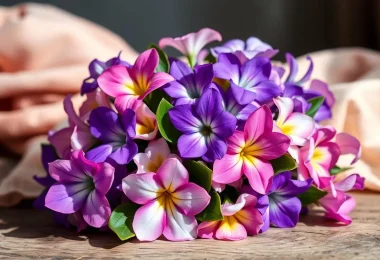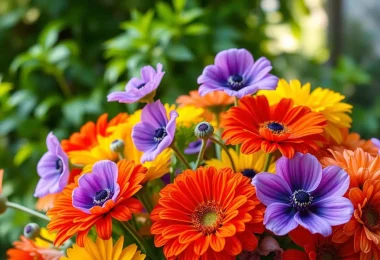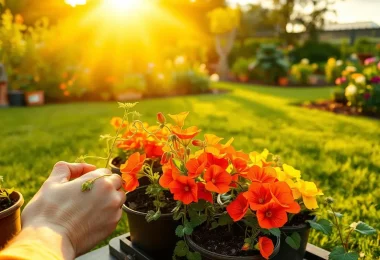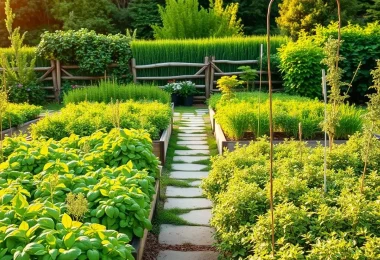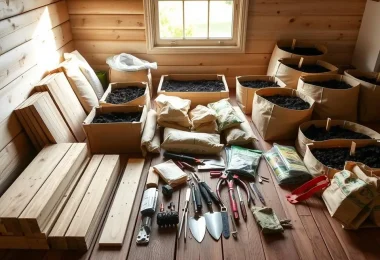Welcome to the world of legume cultivation! Growing beans is a rewarding hobby, perfect for new gardeners. This guide will teach you the basics of planting and caring for beans.

This guide is made just for beginners. It covers key topics like soil prep, bean types, and common mistakes. By the end, you’ll know how to start your own bean garden.
Key Takeaways
- Understand the basics of bean cultivation
- Learn how to prepare the soil for planting
- Discover the different types of beans and their characteristics
- Identify common mistakes to avoid when growing beans
- Get started with your own bean garden
Why Beans Are Perfect for Beginner Gardeners
Beans are great for beginners because they are simple and rewarding. They grow easily and need little care, perfect for new gardeners.
Beans are not just easy to grow. They also offer many benefits, like good nutrition and saving money. Let’s look at these benefits closer.
Nutritional Benefits of Homegrown Beans
Homegrown beans are full of protein, fiber, and vitamins and minerals. They are great for a healthy diet, boosting your well-being. Growing your own beans means they are free from harmful chemicals.
The good stuff in homegrown beans includes:
- High protein content
- Rich in fiber, aiding digestion
- Packed with vitamins and minerals
| Nutrient | Benefit |
|---|---|
| Protein | Essential for muscle repair and growth |
| Fiber | Aids in digestion and promotes satiety |
| Iron | Crucial for healthy red blood cells |
Economic Advantages of Bean Cultivation
Growing beans is also economically beneficial. They are cheap to start and can yield a lot, saving you money. Plus, you can dry them for later, cutting down on buying them often.
Some money-saving points are:
- Low initial investment for seeds and supplies
- High yield per plant, maximizing output
- Ability to save seeds for future planting
Understanding Different Types of Beans to Grow
Beans come in many types, each suited for different gardens and tastes. They fall into two main groups: bush beans and pole beans. Knowing these categories helps you pick the right beans for your garden.
Bush Beans vs. Pole Beans
Bush beans are small, bushy plants that don’t need much support. They grow fast, ready in 50 to 60 days. They’re perfect for small gardens or pots.
Pole beans, by contrast, are climbers that need trellises or stakes. They take 60 to 70 days to mature but yield more over time.
Bush Beans: Ideal for small spaces, mature quickly.
Pole Beans: Require support, higher yield over time.
Popular Bean Varieties for Home Gardens
Popular bush bean varieties include ‘Blue Lake’ and ‘Kentucky Wonder.’ For pole beans, ‘Romano’ and ‘Scarlet Runner’ are favorites. These beans are known for their taste, disease resistance, and high yield.
Selecting the Right Beans for Your Climate Zone
Choosing the right beans depends on your climate. Beans love temperate weather with moderate temperatures. In cooler areas, pick cold-tolerant beans. For warmer places, choose heat-tolerant ones.
| Climate Zone | Recommended Bean Varieties |
|---|---|
| Cooler Climates | ‘Blue Lake’ Bush Beans |
| Warmer Climates | ‘Kentucky Wonder’ Pole Beans |
Essential Tools and Supplies for Growing Beans
Before planting your beans, gather the necessary tools and supplies. The right equipment makes the process easier and ensures a healthy bean crop.
Basic Gardening Equipment Needed
You’ll need basic gardening tools to begin. A garden fork loosens the soil, a rake spreads it evenly, and a hoe weeds. A gardening glove protects your hands from thorns and dirt. Also, a watering can or hose with a spray nozzle waters your plants well.
- Garden fork
- Rake
- Hoe
- Gardening gloves
- Watering can or hose with a spray nozzle
Support Structures for Climbing Varieties
Climbing or pole beans need support. Use trellises, stakes, or bean towers to help them grow upwards. This saves space and promotes healthy growth by improving air circulation and reducing disease risk.
When picking a support, think about your bean plants’ mature size and the material’s durability. With the right tools and supplies, you’re set for a successful bean-growing journey.
Preparing the Perfect Soil for Bean Plants
To grow strong and healthy bean plants, you need to prepare the soil right. Beans are easy to grow but need the right soil to do well. Getting your soil ready can really help your harvest.
Ideal Soil Composition and pH Levels
Beans like soil that drains well and is full of organic matter. The best soil mix holds moisture but also lets water drain to avoid root rot. Beans grow best in a slightly acidic to neutral soil pH, between 6.0 and 7.0. Soil testing is key to knowing your soil’s pH and nutrient levels.
Amending Soil for Optimal Bean Growth
If your soil is heavy clay, sandy, or poor in nutrients, you’ll need to amend it. Adding compost or well-rotted manure can make the soil better. If your soil is too acidic or alkaline, you can adjust it with lime or sulfur. Rich organic matter in the soil helps beans grow well.
Container Gardening Soil Requirements
For container gardening, you need a potting mix that drains well. Don’t use garden soil in pots as it can make the soil too dense. A mix made for vegetables or beans should have peat moss, vermiculite, or perlite to keep moisture in and air out.
| Soil Characteristic | Ideal Condition for Beans |
|---|---|
| pH Level | 6.0 – 7.0 |
| Soil Texture | Loose, well-draining |
| Organic Matter | Rich in compost or manure |
related: How to Grow Nasturtium Plants: From Seeds to Stunning Blooms
When and How to Plant Beans Successfully
To grow beans well, knowing when and how to plant them is key. The right timing and planting method can greatly affect the plants’ health and yield.
Determining the Right Planting Time by Region
The best time to plant beans changes with the region. It depends on the local climate and soil temperature. Beans should be planted when the soil is at least 60°F (15°C). In temperate areas, this is late spring or early summer.
In places with a longer growing season, plant beans every few weeks. This way, you can have a continuous harvest.
| Region | Ideal Planting Time | Soil Temperature |
|---|---|---|
| Temperate | Late Spring | 60°F – 70°F |
| Tropical | Early Summer | 70°F – 80°F |
| Cooler Climates | After Last Frost | 55°F – 65°F |
Direct Sowing Techniques
Beans are usually planted directly in the garden. Start by making a shallow trench or holes about 1 inch deep. Put the seeds in the holes, following the variety’s spacing needs.
Proper Spacing and Depth Guidelines
The spacing and depth of bean seeds vary by type. Bush beans need 2-3 inches between each plant. Pole beans should have 4-6 inches between them.
Plant the seeds about 1 inch deep. This ensures good air flow and prevents disease.
By following these tips and knowing your bean variety’s needs, you can successfully plant and grow beans in your garden.
The Complete Guide to Growing Beans in Different Seasons
To get the most from your bean crop, knowing how to grow them in each season is key. Beans can thrive in many conditions, but adjusting your approach with the seasons is vital. By learning what each season needs, you can improve your bean growing skills and boost bean yields.

Spring Bean Planting Strategies
In spring, plant beans when the soil is warm and frost is gone. Pick a fast-growing variety to make the most of the season. Early planting also keeps pests and diseases at bay.
Summer Bean Maintenance
In summer, beans need steady water, more so when they’re making pods. Mulch helps keep the soil moist and weeds away. Keep an eye out for signs of stress or disease to keep your beans healthy and boost bean yields.
Fall Bean Varieties and Considerations
For a fall harvest, plant beans 8 to 10 weeks before the first frost. Choose varieties that do well in cooler weather and mature quickly. Fall beans need less care because of fewer pests and diseases, making it great for organic gardening practices.
Watering Strategies for Healthy Bean Plants
Proper watering is key for healthy bean plants. They need steady moisture, most when they’re making pods. If the water is off, plants get stressed, grow less, and get sick easier.
Establishing Proper Watering Routines
To water right, feel the soil with your finger. If it’s dry, it’s time to water. Water deeply to help roots grow strong. Shallow water weakens roots.
Watering at the right time is also important. Water in the early morning so plants drink all day. Don’t water at night to avoid fungal diseases.
Signs of Overwatering and Underwatering
Too much or too little water harms bean plants. Overwatering shows in yellow leaves and soggy soil. Underwatering makes leaves wilt and plants grow slow. Watch your plants to catch these signs and change your watering.
Knowing your bean plants’ water needs helps them grow well. Adjust your care to avoid problems and keep them healthy.
Fertilizing Your Bean Plants Effectively
Bean plants need the right nutrients to grow well. Understanding their needs is key to a good harvest. It’s important to know how to give them what they need.
Understanding Bean Nutritional Needs
Bean plants need a mix of nutrients to thrive. They need nitrogen for leaves, phosphorus for roots and flowers, and potassium for overall health.

Organic vs. Synthetic Fertilizer Options
You can use organic or synthetic fertilizers for bean plants. Organic fertilizers like compost are slow but good for the soil. Synthetic fertilizers work fast but can harm soil if used too much. Mixing both can be a good strategy.
Fertilizing Schedule Throughout the Growing Season
Having a fertilizing plan is crucial for a good bean harvest. Start with a balanced fertilizer when you plant. Then, add more nutrients as the plants grow. For example, use a high-phosphorus fertilizer when they start flowering to get more blooms.
| Growth Stage | Fertilizer Type | Application Rate |
|---|---|---|
| At Planting | Balanced (10-10-10 NPK) | 1 cup per 10 feet |
| During Flowering | High Phosphorus (10-20-10 NPK) | 1/2 cup per 10 feet |
Essential Bean Plant Care and Maintenance
Bean plant care is key to their health and high yield. Keeping them well-maintained boosts their productivity.
Mulching Benefits and Techniques
Mulching helps bean plants by keeping soil moist and weed-free. Use a 2-3 inch layer of organic material like straw or wood chips. Keep it a few inches from the stems.
Mulching also prevents soil erosion and improves soil health. It keeps your garden neat.
Weeding Strategies Around Bean Plants
Weeds harm bean plants by taking their water, nutrients, and light. Regular weeding ensures your plants get what they need.
Use a hoe or hand-pull weeds carefully. Weeding is easier when the soil is moist. This way, you can remove weeds completely.
Supporting and Training Climbing Varieties
Climbing bean varieties need support. Use trellises, stakes, or bean towers for them to climb on. Gently twine the vines around the support.
Proper support keeps beans organized and promotes air circulation. This helps prevent disease. Check and adjust the support as your plants grow.
Identifying and Managing Common Bean Plant Diseases
It’s important for beginner gardeners to know how to spot and handle diseases in bean plants. These diseases can hurt the yield and quality of your crop.
Bean plant diseases come from bacteria, fungi, or viruses. Knowing what causes and shows these diseases is key to managing them well.
Bacterial and Fungal Infections
Bacterial and fungal infections are common in bean plants. Bacterial blight and halo blight are big problems, as are fungal infections like powdery mildew and root rot. These diseases can lead to leaf spots, blight, and wilting.
Symptoms and Effects: Bacterial blight makes leaves water-soaked, while halo blight creates yellow halos. Fungal diseases like powdery mildew cover leaves in a white, powdery coating.
Viral Diseases in Bean Plants
Viral diseases, like bean common mosaic virus and bean yellow disorder, can also hit bean plants. Aphids and other insects spread these viruses.
Management Strategies: Getting rid of infected plants, controlling insects, and picking resistant varieties are important steps to fight viral diseases.
Preventative Measures and Organic Treatments
It’s better to prevent disease than to treat it. Crop rotation, keeping things clean, and starting with disease-free seeds are good ways to prevent disease. Organic treatments include copper-based fungicides and biological controls.
| Disease | Symptoms | Management |
|---|---|---|
| Bacterial Blight | Water-soaked lesions | Copper-based fungicides, remove infected plants |
| Powdery Mildew | White, powdery coating | Improve air circulation, use fungicides |
| Bean Common Mosaic Virus | Mosaic patterns on leaves | Remove infected plants, control aphids |
By knowing and managing common bean plant diseases, gardeners can keep their crops healthy and enjoy a big harvest. Keeping an eye on your plants and acting fast is crucial for managing diseases well.

Dealing with Bean Plant Pests and Problems
Managing pests and problems is key to growing beans well. Bean plants face many issues that can harm their health and yield. Knowing these challenges helps boost bean yields and get a healthy crop.
Common Insect Pests That Target Beans
Beans are often attacked by pests like aphids, spider mites, and Japanese beetles. These pests can seriously damage the plants, lowering the yield. Aphids, for example, suck plant sap and can spread diseases. It’s important to watch for pests early.
Natural and Chemical Control Methods
Controlling pests needs both natural and chemical methods. Natural ways include using beneficial insects, like ladybugs, to eat aphids. Chemical options, like insecticidal soap or neem oil, can also work. It’s important to pick methods that are good for the environment.
Troubleshooting Poor Growth and Yellowing Leaves
Poor growth and yellow leaves can mean many things, like not enough nutrients, too much water, or bean plant diseases. A table below lists common problems and solutions to help fix them.
| Symptom | Possible Cause | Solution |
|---|---|---|
| Yellowing Leaves | Nutrient deficiency | Fertilize with balanced fertilizer |
| Poor Growth | Overwatering | Adjust watering schedule |
| Leaf Spots | Fungal infection | Apply fungicide, improve air circulation |
Companion Planting for Successful Bean Growing
Companion planting can really help your bean crop grow better. By picking the right plants to grow with your beans, you make your garden stronger and more balanced.

Beneficial Plant Combinations
Some plants are great with beans, like providing support, improving soil, or keeping pests away. For example, corn and beans work well together. Corn stalks help beans grow up, and beans make the soil better for corn.
Marigolds keep nematodes and other pests away, and radishes keep cucumber beetles from spreading disease to beans. Nasturtiums also help by fighting off aphids, whiteflies, and other pests.
“The Three Sisters method is an ancient way to grow. It combines corn, beans, and squash. This way, all three plants do well together.”
Plants to Avoid Growing Near Beans
But, some plants don’t get along with beans. For instance, Brassica family members (like broccoli and kale) can get sick like beans. This makes beans more likely to get sick too.
Don’t plant beans near Allium family members (such as onions and garlic) either. These can slow down bean growth or make them more prone to disease. Knowing these plants helps you plan a better bean garden.
Harvesting and Storing Your Bean Crop
The joy of growing beans reaches its peak in the harvest. This step requires careful attention. Harvesting beans at the right time makes them tender and flavorful, enhancing your cooking.
Indicators of Bean Readiness
Knowing when to harvest your beans is key. For green beans, they’re ready when they’re bright green and tender. Check the days to maturity for your specific bean variety.
Proper Harvesting Techniques
To harvest beans well, gently pull or cut them from the plant. This avoids damaging the stem or roots. Bush beans are easy to harvest. Pole beans might need you to climb through the plant to find the ripe ones.
| Bean Type | Harvest Time | Tips |
|---|---|---|
| Bush Beans | 50-60 days | Check frequently as they mature quickly. |
| Pole Beans | 60-70 days | Navigate through the climbing structure carefully. |
Seed Saving and Storage Methods
If you want to save seeds, let some beans dry on the plant. Dry them completely, then store them in a cool, dry place. This way, you can enjoy your beans for years to come.
By following these tips, you’ll have a great harvest of delicious beans. Whether you’re new to gardening or experienced, growing and harvesting beans is very rewarding.
Conclusion: Enjoying the Rewards of Your Bean Growing Journey
Growing beans can be very rewarding. It gives you a lot of delicious and healthy legumes. By using the bean growing tips from this guide, you’ll become a great bean grower.
Growing beans needs careful attention. You must prepare the soil right and handle pests and diseases. With the right steps and patience, you’ll have a great bean crop. This will make you feel proud and add flavor to your meals.
Whether you’re experienced or new to gardening, harvesting your beans is special. Be proud of your effort and enjoy your hard work. With these bean growing tips and dedication, you’ll soon enjoy fresh, homegrown beans.



